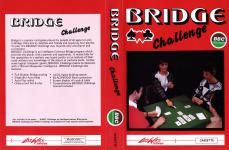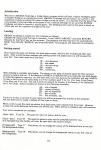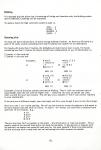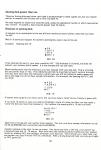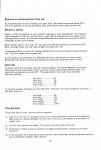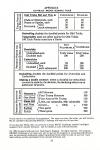
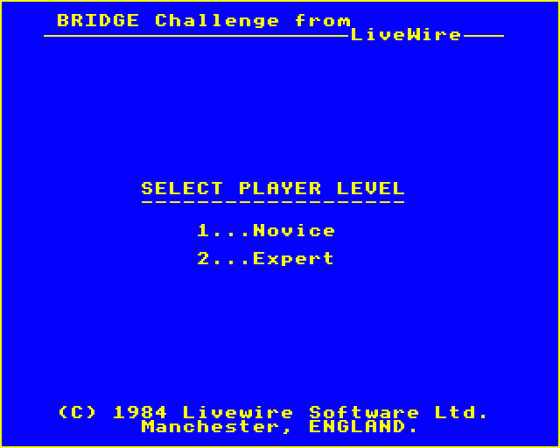

| Genre: | Graphical Bridge Simulation |
| Publisher: | Livewire |
| Cover Art Language: | English |
| Machine Compatibility: | BBC Model B, BBC Model B+, BBC Master 128, Acorn Electron |
| Release: | Professionally released on Cassette |
| Available For: | BBC/Electron |
| Compatible Emulators: | BeebEm (PC (Windows)) PcBBC (PC (MS-DOS)) Model B Emulator (PC (Windows)) Elkulator 1.0 (PC (Windows)) |
| Original Release Date: | 1st December 1985 |
| Original Release Price: | £9.99 |
| Market Valuation: | £2.50 (How Is This Calculated?) |
| Item Weight: | 64g |
| Box Type: | Cassette Single Plastic Clear |
| Author(s): | - |
Variant Items
There are 0 other items featuring this same game (that we know about!). Click any of them for their details.
Active Auctions
Closed Auctions
Buy It
Unfortunately no-one is currently selling this item.
Auction Price Watch
Worried you're being ripped off? Closing prices on eBay can help you decide what a reasonable price is for a particular item.

A&B Computing
1st December 1985
I find it hard to believe that card games cannot be simulated with much greater playing strength than Live Wire have achieved... I really cannot recommend these programs for any significant entertainment or educational value. Read Review
Full Instructions
Introduction
BRIDGE CHALLENGE
FOR THE
BBC 'B' AND ELECTRON
♠ ♥ ♦ ♣
Welcome to Bridge Challenge, a bridge player program which will play a highly intelligent game of Rubber Bridge at an experienced level. BRDIGE CHALLENGE bids and plays your partner's and opposition's hands including full rubber bridge scoring on screen. It is assumed that the player has a knowledge of playing bridge as this game is not a tutorial although we are sure that Bridge Challenge will help to improve a player's game. The bidding system used in this game is based on ACOL and will be explained throughout the text.

Getting Started
Once loaded the game will display the level select screen, which is also re-displayed after each game. After a level has been selected, the bidding screen will appear and you will be asked for your bid. Your reply must be of the form:
| 1D | .. | one diamond |
| 1S | .. | one spade |
| 1N | .. | one no trump |
| DB | .. | double |
| NB | .. | no bid etc |
When bidding is complete play begins. The player to the right of dummy plays the first card and dummy's hand is laid out. If the declarer is NORTH or SOUTH then you must play out both hands. If defending against a contract, you will play only your own hand as the computer will play NORTH. To play a card type in the value using 2 to 9 for numbers with T for 10, J for Jack, Q for Queen, K for King and A for Ace. The suit is keyed in using S for Spades, H for Hearts, D for Diamonds and C for Clubs. Some examples are shown in the following examples:
| AS | .. | ace of spades |
| QH | .. | queen of hearts |
| JD | .. | jack of diamonds |
| TC | .. | ten of clubs |
| SH | .. | five of hearts, etc |
If you want to play a card not in your hand you will be prompted for another as the computer will not allow you to make a mistake of that type or cheat.
When a trick is won the cards are shown for a short time, then cleared from the screen. However, to keep the cards displayed hold down the SPACE bar. When the bar is released, play will continue.
Four more commands are available:
(Auto-bid). Type O. This asks the micro to make a bid for you.
(Auto-play). Type O. This asks the game to play out the complete hand for you. It is intended that this facility will only be used when the result is certain.
(Foreground). Type F. This allows you to change the colour of the displayed text to any but the background colour.
(Background). Type B. This allows you to change the background colour to any text but that of the foreground.
Bidding
It is assumed that the player has a knowledge of bridge and therefore only the bidding system used in Bridge Challenge will be explained.
To assess a hand, the high card point system is used, i.e.
| ACE | ... | 4 |
| KING | ... | 3 |
| QUEEN | ... | 2 |
| JACK | ... | 1 |
Opening Bids
To open, the player should have an above average holding of points. As there are 40 points in a pack of 52 cards, a hand containing more than 10 points may qualify for an opening bid.
For hands with more than 12 points, the biddable suit must have at least 4 cards. For hands containing less than 13 points the player should have compensation by way of distribution i.e.
12 points + a five card suit
11 points + a six card suit
| Examples: a) |
♠ Q 6 3 ♥ A K 8 4 3 ♦ 5 ♣ K 10 7 7 BID 1H |
b) |
♠ K Q J 7 6 3 ♥ A 4 ♦ J 10 8 4 ♣ 9 BID 1S |
| c) |
♠ A Q J 10 ♥ A J 9 ♦ 10 8 ♣ Q 10 7 4 BID 1C |
d) |
♠ A K 9 8 ♥ K Q J 7 ♦ K 8 4 ♣ 10 7 BID 1S |
Examples c) and d) illustrate another principle of bidding. That is 'with two adjacent suits of equal length, open the suit with the higher rank' - unless the two suits are spades and clubs, when you bid the lower suit (clubs). This will give you a suitable re-bid if your partner responds to your opening bid.
If the suits are of different length, open the longer suit first, even though it may not be the stronger.
Now on to the 1-no-trump opening. We will use the strong no trump throughout as this seems to be more popular than the weak no trump. To open 1-no-trump, you must have a balanced hand and from 15 to 19 points. E.g.:
| A J 8 K Q 10 A J 9 7 Q 10 9 |
There is one more 'bid' to consider at this point - the informatory or 'take out double'. This is usually made at the one bid level and is not made for penalties. It asks partner to respond with his best suit, no matter how weak his hand may be. He must respond if there is no intervening bid but may padd with a weak hand and an intervening bid which removes the double.
Opening Bids Greater Than One
These are forcing bids used when your hand is strong enough to make a game call, but you require partner to respond with his best suit to find a suitable fit.
He must respond no matter how weak his hand, unless the opposition has bid, in which case partner may 'no bid'. To qualify a hand must be greater than 22 points.
Response To Opening Bids
A response to an opening bid at the one bid level requires at least 6 points. Otherwise you must 'no bid'.
With 6-9 points and support for partners opening bid, raise to two in his suit.
Example: Opening bid 1H
| ♠ 9 8 ♥ Q 9 7 5 ♦ K 5 4 ♣ Q 8 7 2 BID 2H |
If the opening bid was 1S, your reply would be 1NT. This indicates 6-9 points, but does not support your partner's bid of spades. It is the cheapest bid you can make.
When holding more than the minimum, you may respond with your best suit. This is a forcing bid and partner must re-bid. If he rebids his suit then he must hold at least 5 cards in that suit. You may have more than the minimum, in which case you will be looking to make a game call, but at this stage you do not have enough information. For example, the opening bid is 1C and you hold:
| ♠ A Q 3 ♥ A Q 9 6 2 ♦ J 10 8 ♣ 9 7 BID 1H |
If your opener then supports your heart call to 2H, you may make a 'jump' bid to 4 hearts (a game call).
If you hold 16 points or more you must be thinking in terms of a slam, but first you may make a 'jump' bid (bid one more than necessary). For instance, the opening bid is 1D and you hold:
| ♠ A K 10 9 7 ♥ A Q ♦ K 10 9 4 ♣ 10 7 BID 2S |
Again this is forcing and your partner must respond. You may now have enough information to use the BLACKWOOD slam convention (See Slam Bids).
Another response is the reply to one no trump. You know that with a 1NT bid, your partner has a balanced hand and 15-19 points. With more than the minimum points holding you may support his bid by bidding 2NT, but holding a minimum, your best suit. This is known as a 'weak take-out' and partner may pass if he bid 1NT on a minimum. With a strong balanced hand you may go straight to 3NT, game call.
Response to opening greater than one
As an opening bid of two is forcing, you must reply, the negative response being 2NT. You may pass only if the second player bids, when partner may make another bid.
Rebids By Opener
These re-bids will depend on your partner's response to your opening bid. For instance, with a response of 1NT to your suit bid, if your hand is balanced and you opened on a minimum then no bid. If your hand is distributional then rebid your suit as it is totally unsuitable to play in no trumps.
With a simple raise in your suit, 1H-2H, and with minimum game points, you should no bid. With a stronger hand you may raise straight to a game call, 4H.
A response of 2NT to your 1NT should indicate that you hold at least 25 points between you. Call 3NT, again this is a game call.
If your partner has responded in a different suit this is forcing and you must rebid. Remember that when you open the bidding you must have a suitable rebid in mind.
Slam Bids
To make a slam bid you must hold the Aces and Kings. The BLACKWOOD convention allows you to ask your partner to tell you how many of these high cards he holds. To enter this conversation you must bid 4NT. This asks partner how many Aces he holds. His reply must be:
| No Aces | ........ | 5C |
| One Ace | ........ | 5D |
| Two Aces | ........ | 5H |
| Three Aces | ........ | 5S |
To find the number of Kings you then bid 5NT. This asks "How many Kings do you have?". His reply must be:
| No Kings | ........ | 6C |
| One King | ........ | 6D |
| Two Kings | ........ | 6H |
| Three Kings | ........ | 6S |
| Four Kings | ........ | 6NT |
Opening Leads
These take many forms. Here are a few examples:
- Lead from the top of a sequence such as Ace from Ace/King or King from King/Queen. With a lead of a King, although you may lose to the Ace, your Queen is promoted to a master card.
- Lead to your partner's strength. If he made a bid then lead to his suit.
- Sometimes, it helps to lead to dummy's strength, giving partner a chance to overtake the trick.
- If you are stuck for a lead then a card from the 'top of nothing' will give nothing away and you are probably leading a loser anyway.
Scoring
Scoring is normal Rubber Bridge scoring therefore only the screen layout will be explained. For the full score table see the Appendix.
| GAMES | .......... | Numbers of games won this session |
| RUBBERS | .......... | Number of rubbers won this session |
| DOUBLED | .......... | Doubled on last game |
| VULNERABLE | .......... | Vulnerable on last game |
| BONUS | .......... | Any bonus earned |
| TOTAL | .......... | Total number of points |

Contract Bridge Scoring Table
| Trick Points For Declarer |
Odd Tricks Bid and Won in | UNDOUBLED ______________ |
DOUBLED ______________ |
|
| Clubs or Diamonds, each | 20 | 40 | ||
| Hearts or Spades, each | 30 | 60 | ||
| No-trump | { first | 40 | 80 | |
| { second | 30 | 60 | ||
|
Redoubling doubles the doubled points for Odd Tricks.
Vulnerability does not affect points for Odd Tricks. |
||||
| Premium Points For Defenders/ Declarers |
Overtricks | NOT VULNERABLE ______________ |
VULNERABLE ______________ |
|
| Undoubled each | Trick Value | Trick Value | ||
| Doubled each | 100 | 200 | ||
| Undertricks | ||||
| Undoubled, each | 50 | 100 | ||
| Doubled | { first | 100 | 200 | |
| { each subsequent | 200 | 300 | ||
|
Redoubling doubles the doubled points for Overtricks and Undertricks.
Making a double contract: where a doubled (or redoubled) contract is made by the declarer, the declaring side score an additional 50 points. |
||||
| Premium Points For Declarer/ Holder |
Honours In One Hand Slams Bid and Won Rubber Points |
{ All Honours { Four Trump Hours { Four Aces at No Trump / Little, not vulnerable, 500; vulnerable \ Grand not vulnerable, 1000; vulnerable / Two game \ Three game |
150 100 150 750 1500 700 500 |
|
Finally there is no substitute for experience. The more you play, the better you will become. We are confident that playing Bridge Challenge will help you do just that!
If you also play Whist, then you are sure to enjoy Whist Challenge , another intelligent program from Livewire Software. Ask for details at your software stockist.
Screen Designers
The following utilities are also available to allow you to edit the supplied screens of this game:
Cheats
Download
A digital version of this item can be downloaded right here at Everygamegoing (All our downloads are in .zip format).
| Download | What It Contains |
|---|---|
| A digital version of Bridge Challenge suitable for BeebEm (PC (Windows)), PcBBC (PC (MS-DOS)), Model B Emulator (PC (Windows)), Elkulator 1.0 (PC (Windows)) | |
| A digital version of Bridge Challenge suitable for BeebEm (PC (Windows)), PcBBC (PC (MS-DOS)), Model B Emulator (PC (Windows)), Elkulator 1.0 (PC (Windows)) |
Report A Problem
We thank you from the bottom of our hearts if you report something wrong on our site. It's the only way we can fix any problems!
You are not currently logged in so your report will be anonymous.
Add Note
Release Country
Change the country to update it. Click outside of this pop-up to cancel.
Scan Of Selected Article
If you auction an item, it will no longer show in the regular shop section of the site.




